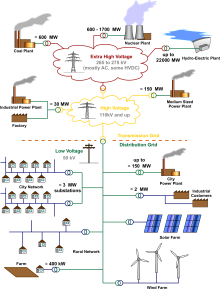Automatic Generation Control
– Before automatic generation control, one generating unit in a system would be manually adjusted to control the balance between generation and load.
– The remaining units would be controlled with speed droop to share the load.
– Automatic generation control allows multiple units to participate in regulation, improving system efficiency, stability, and economy.
– It reduces wear on a single unit’s controls.
– It helps maintain power interchanges over tie lines in a grid with adjacent control areas.
Types of Control
– Turbine-governor control (TGC) is used to maintain the desired system frequency by adjusting the mechanical power output of the turbine.
– TGC is necessary because the decrease in stored kinetic energy of turbine generators leads to a decrease in frequency.
– Load-frequency control (LFC) is employed to meet an area’s load demands and return the steady-state frequency of the system to zero.
– Economic dispatch minimizes total operating costs by determining the real power output of each generating unit to meet a given load.
– Economic dispatch considers different costs of generating units and transmission losses.
Turbine-Governor Control
– Turbine generators in a power system have stored kinetic energy due to their large rotating masses.
– The purpose of turbine-governor control is to maintain the desired system frequency.
– The frequency-power relation for turbine-governor control is represented by the equation: Δp_m = Δp_ref – 1/Rimes Δf.
– Δp_m is the change in turbine mechanical power output.
– R is the regulation constant quantifying the sensitivity of the generator to a change in frequency.
Load-Frequency Control
– Load-frequency control (LFC) is employed to meet an area’s load demands and stabilize system frequency.
– LFC operates with a response time of a few seconds.
– It helps keep system frequency stable.
– LFC aims to return the steady-state frequency of the system to zero.
– It assists in maintaining system stability.
Economic Dispatch
– Economic dispatch minimizes total operating costs in an area.
– It determines the real power output of each generating unit to meet a given load.
– Different generating units have different costs and transmission losses.
– An economic dispatch algorithm runs periodically to select the combination of generating unit power setpoints that minimizes overall cost.
– Constraints such as transmission limitations or system security are considered in economic dispatch. Source: https://en.wikipedia.org/wiki/Automatic_generation_control
In an electric power system, automatic generation control (AGC) is a system for adjusting the power output of multiple generators at different power plants, in response to changes in the load. Since a power grid requires that generation and load closely balance moment by moment, frequent adjustments to the output of generators are necessary. The balance can be judged by measuring the system frequency; if it is increasing, more power is being generated than used, which causes all the machines in the system to accelerate. If the system frequency is decreasing, more load is on the system than the instantaneous generation can provide, which causes all generators to slow down.

